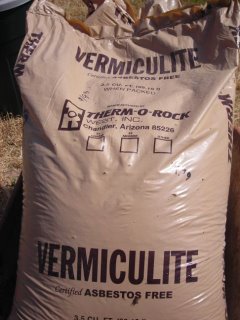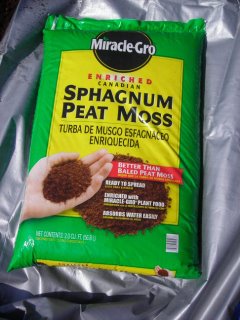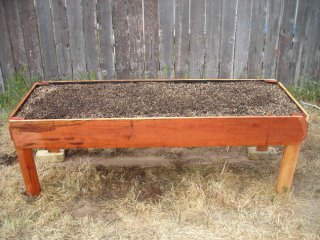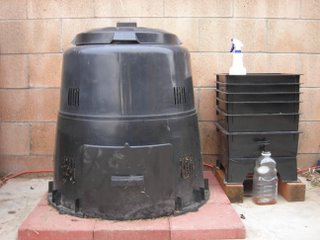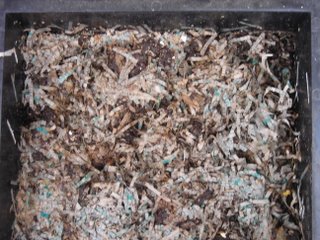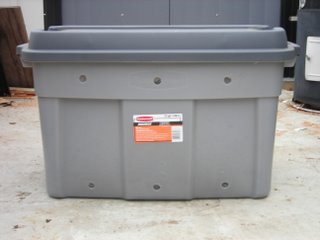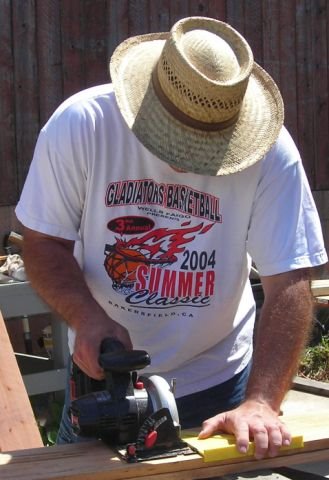You might remember from a previous post that I am not a true "green" organic gardener. I have used commercial fertilizers in my garden, but I have yet to use pesticides on my fruits and vegetables and if I can avoid it .. I will.
I've been looking for a way to reduce or possibly even eliminate the amount of fertilizer I use in the vegetable garden. Mel's heavy use of blended compost in the SFG method is designed to eliminate the need for fertilizer, so that's taken care of, but I still have one "traditional" planter that is filled with potting soil; then there is the apricot tree that I planted in a 1/2 wine barrel, my wife's tomatoes (also in a 1/2 wine barrel), my tomatoes (in inverted planters .. more on that adventure in a future post), and the other various plants I have in potting soil. I also wanted to look into natural pesticides in case I run into a problem with the wrong kind of bug. Now, I've taken a step in the right direction by using cedar and redwood to construct my planters, both woods have natural insect repelling properties.
I came across a few internet articles that discussed the benefits of "compost tea." In summary, compost tea, if brewed properly, is both a fertilizer and a "bad" insect/organism repellant. I didn't quite understand all the science involved, but I think compost tea may be what I have been looking for. (Read about the science behind compost tea)
The recipe is simple enough: water + compost + aeration + molasses + time = compost tea.
All the articles I read used a 5 gal. bucket as the kettle; the amount of compost varied from about a gallon worth, to half of the bucket. Aeration is accomplished using an aquarium air pump and air stones; molasses (about an ounce) is added to feed the microorganisms while brewing for about two to three days. After searching around I found an article that described how to make your own compost tea brewer .. here's what I did:
I used a 5 gal. paint bucket. I washed out the bucket and then drilled several 1/4 in holes around the top of the bucket, just under the rim. You need sufficient holes for air to vent out of the bucket while the tea brews. If you don't have sufficient venting ..... boom!

I drilled a hole in the center of, and two additional holes closer to the edge of the lid. 
I used two tube socks to hold the compost. Some of the articles I read had the compost loose in the bucket which was filtered using cheese cloth or a similar material/mesh after the brewing was complete. 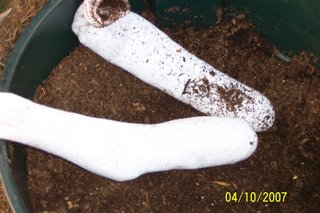
I purchased a cheap dual outlet aquarium air pump at Wal-Mart. I also purchased two large air stones, two small air stones, two "T"s and 25' of tubing. 
I filled the socks about 3/4 full of compost and then ran about 12" of air tubing (with a small air stone attached to the end) all the way into each sock and then worked it into the center of the compost. I connected the two air tubes using a "T". I used about an arms length of twine to tie off the end of the sock and to hold the air line in place.


Next I ran the both ends of the twine up through the hole in the center of the lid, and then one each down through the two additional holes in the lid. I pulled the string tight so that the socks were up against the lid and then tied off the strings so that the socks would dangle while the tea brewed. 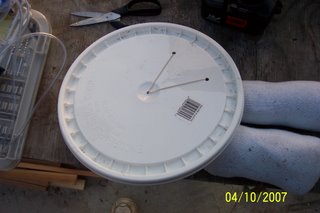

I cut about an arms length of air tubing and attached one end to the "T". When I was ready to put the lid on I ran the long air tube out of the bucket through one of the holes that I drilled near the rim.
Next, I attached about 8" of air tubing to each of the two large air stones, connected the ends to the second "T", attached an arms length of air tubing to the "T" and then ran it out another one of the drilled holes. 
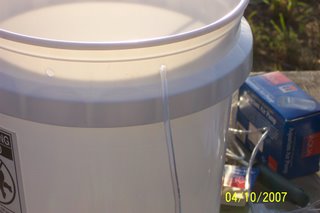
If you are using tap water from a municipal water supply you must aerate the water for at least an hour so that any chlorine can evaporate. The chlorine will kill the micro-organisms in the compost.
Add about an ounce of unsulfured molasses to the bucket. 
I used an air pump with two air outlets. If your air pump has only one outlet you will need to use a gang valve to split the air supply. I could have used a gang valve instead of the "T"s. If a gang valve is used you won't be able to put a lid on the bucket because the valve will hang from the rim. In my case I put the lid on, plugged in the air pump, connected the airlines and let it brew. 
I brewed this compost tea for 48 hours. The presence of foam is a good thing, it indicates that the process is working. 

The socks did a good job holding the compost, there was very little "sludge" in the bottom of the bucket. I emptied the compost from the socks into the compost bin. I like how the socks worked, but I think will look for a thin mesh bag for next time.
I used the compost tea as a fertilizer in the soil and as an insect repellant on the plants. I think I will brew a batch about every two weeks and see how it performs.




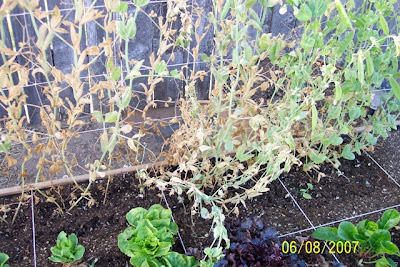
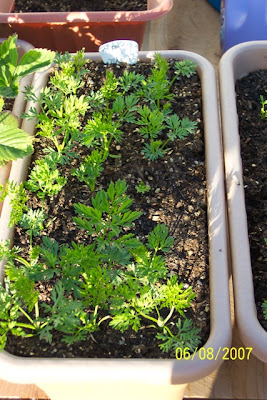
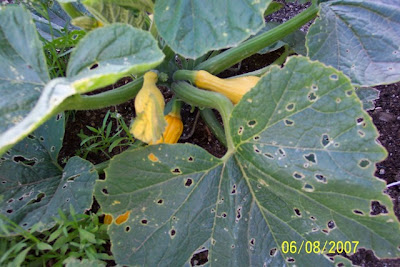
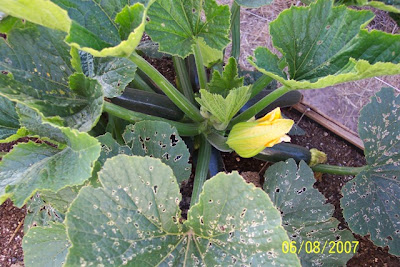
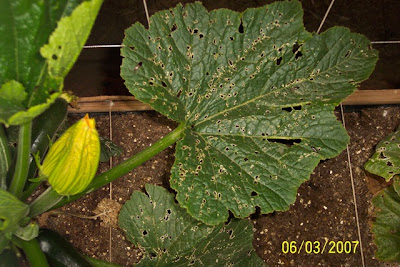
















 The only thing planted in #1 so far is a zucchini in B1. In the picture above you can see two of the screen frames that I built. These two screen frames are only 1" wide so they are modular, I can use 1 or 2 depending on what's been planted and whether or not I need the entire bed protected. In the picture I have one frame lengthwise across the back six squares.
The only thing planted in #1 so far is a zucchini in B1. In the picture above you can see two of the screen frames that I built. These two screen frames are only 1" wide so they are modular, I can use 1 or 2 depending on what's been planted and whether or not I need the entire bed protected. In the picture I have one frame lengthwise across the back six squares.
 B1 & B2 = Watermelon; B3 & B4 = Sugar Snap Peas (9 per sq. ft) .. I didn't buy enough so I only have 6 per sq. ft.; B5 & B6 = Watermelon
B1 & B2 = Watermelon; B3 & B4 = Sugar Snap Peas (9 per sq. ft) .. I didn't buy enough so I only have 6 per sq. ft.; B5 & B6 = Watermelon
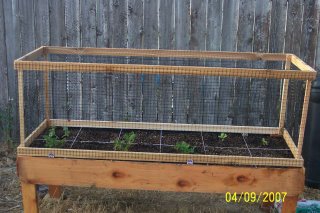 B1 & B2 = Watermelon; B3 & B4 = Empty; B5 = Cantaloupe; B6 = Cantaloupe
B1 & B2 = Watermelon; B3 & B4 = Empty; B5 = Cantaloupe; B6 = Cantaloupe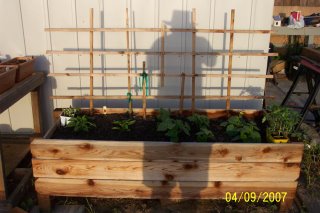 From L to R: Green bell pepper, red bell pepper, green beans (5 plants) and a cucumber on the back right. The plants still in the containers are extra tomatoes and cantaloupe that I'm not yet sure what I am going to do with.
From L to R: Green bell pepper, red bell pepper, green beans (5 plants) and a cucumber on the back right. The plants still in the containers are extra tomatoes and cantaloupe that I'm not yet sure what I am going to do with.
